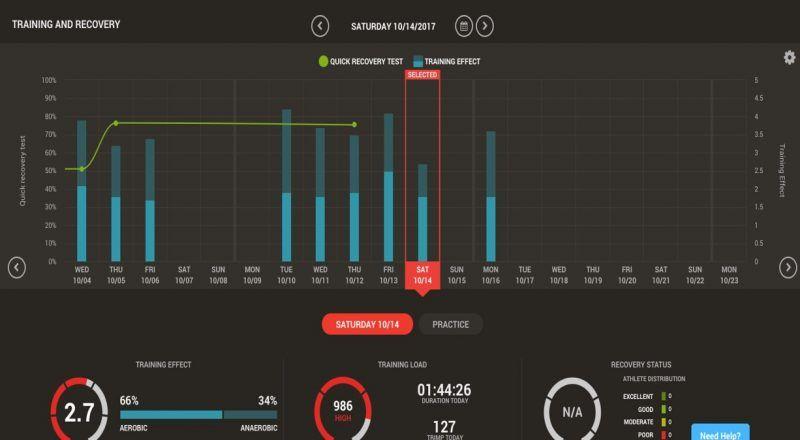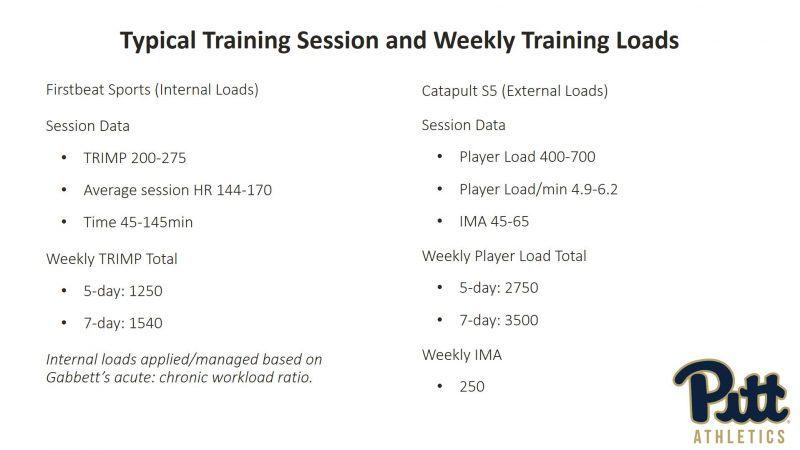
 Tim Beltz, M.Sc., is a Master Strength and Conditioning Coach certified by the Collegiate Strength and Conditioning Coaches Association (CSCCA). He has been a member of the University of Pittsburgh training staff since 1999, where he currently specializes in preparing student athletes for the challenges of collegiate basketball and beyond.
Tim Beltz, M.Sc., is a Master Strength and Conditioning Coach certified by the Collegiate Strength and Conditioning Coaches Association (CSCCA). He has been a member of the University of Pittsburgh training staff since 1999, where he currently specializes in preparing student athletes for the challenges of collegiate basketball and beyond.
Like a lot of strength coaches, Beltz can be a little hesitant to talk specific numbers, when it comes to setting up the ideal training load for players on the team. It’s not just trying play things close to the vest. “Everything is very individual specific for a women’s basketball team at the Division 1 level,” he explains.
He is also quick to point out that, to be effective at the highest level, a strength coach has to be able to look beyond the numbers. “Every single day, during warm-up, I go through our personnel, asking them questions about how they are feeling, where they’re sore,” he says. “That’s the easiest way to keep things simple. You don’t need technology for any of that, it’s just simple conversation.” But it doesn’t stop there.
Probably best thing that strength coaches can do is understand their personnel, making sure that they’ve classified their personnel properly, having your team average versus your individual average, looking at the standard bell curve … or buckets.”
“It used to be we would just put athletes together as just the offensive line, the defensive line; or guards and bigs; or ones and twos, then threes, and then fours and fives. In basketball, I think that’s changed, now you need to know, to understand your best performers versus your worst performers, look at their individual differences.”
Helping Athletes Compete Against Themselves Over Time
The ability to track intensity and quantify training loads using technology plays a big role in today’s game, giving team experts the ability to see in specific terms how individual athletes are impacted by training and how they respond at a physiological level.
“We’ve only been using [Firstbeat Sports] for the past calendar year… but looking at the difference in patient history or percent change from year to year, I think is critically important for evaluating how efficient or effective your preseason conditioning programs have been on individuals. We’re looking to build performance gains year to year, through our offseason, through our preseason, all the different challenging times a year that we have for them.”
According to Beltz, when it comes to physiological data and training loads, the key is to avoid targeting general one-size-fits-all numbers, but to accurately assess individual athletes, comparing how they are doing now to their own data across their personal training history.
“I think it’s important to look at last year’s data versus this year’s data, and have a good feel for whether they are over-reaching or under-reaching. I think that’s a better way of looking at it versus just looking at somebody’s TRIMP scores and saying ‘oh, they went 300 today, they’re overtrained.’ Looking at it that way gives it a better perspective in my eyes.”
Monitoring individual adaptations and training responses of healthy athletes reveals big-picture progress and development, but according to Beltz, the importance of this information kicks into overdrive when it comes to progressing athletes through return-to-play scenarios.
“For our return-to-play process, I use a percent based system for full go, so we’ve got a few student-athletes, or I should say if you’ve got an individual right now that’s on a return to play protocol, and what I’ll do is I’ll look at the last five practices of data, GPS vs. heart rate data. Then I’ll put together a percentage based system to get them to return to play. I think that’s the best way to have success with your athletes.”
In terms of reintroducing training loads and bringing athletes back up to speed, Beltz uses an approach based on the Tim Gabbett studies of the acute:chronic workload ratio. The same approach that Gabbett outlined in a previous Firstbeat Sports webinar, “Solving the Training-Injury Prevention Paradox,” earlier this year.
Getting Down to the Details
While looking at the data at an individual level will provide the greatest insight, there is value to be gained from a bird’s-eye perspective as well – but according to Beltz, “it varies a lot.” Considerations include the time of year, point in the season, and different types of conditioning modes and modalities used to achieve those training loads.
“From Firstbeat Sports, we’re using the TRIMP score, and then I’ll also look at Average HR multiplied by session minutes, and then I also look at session minutes multiplied by their post-workout RPE.”
Individual TRIMP (Training Impulse) scores are a popular, heart rate-based, method of quantifying training loads. The accumulation curve for TRIMP is designed to model the lactate accumulation curve, increasing exponentially with intensity level.
“[For a typical session] our average TRIMP-score is between 200-275, session HR between 144-170 bpm. Our time is from 45 minutes to about 145 total minutes, a weekly [5-day] total is around 1250 and our seven-day total is around 1540,” he says.
What TRIMP numbers do NCAA Division I basketball teams typically see in games? Listen to the Firstbeat Sports Podcast to find out
To gain additional context, Beltz compares those internal load numbers from the Firstbeat Sports platform with external load data captured by the teams GPS-based system.
“[For typical external loads] we’re looking at a Player Load of 400-700 with a Player Load per Minute of 4.9-6.2, which is important for looking at our session intensity, and obviously there are different drills during practice that you can map in.”
Getting It Right Means Flexibility to Match Individual and Team Needs
The ability to effectively capture and account for the impact of different types of training sessions is vital to informational utility. Day-to-day training activities vary a lot depending on team experience, composition and proficiency.
“In 2008, we had a really good group of men’s basketball players, and we ran very, very little, but we played 5-6 days a week, for two hours at a time. It would not be uncommon for us to play in the summer. Our days that we played in the summer would be Tuesdays and Thursdays, Fridays, and Saturdays … It didn’t hurt that we had a few NBA players on that roster, but at the same time the level of pickup, the amount of pickup has to come into play.”
So how does it all come together? For Beltz, there are multiple concerns and it’s a frequent topic of conversation with his colleagues. Key to the discussion are the dual goals of player development, but also ensuring they are at an optimal level when it matters most.
“I’m a big fan of metabolic stress, but it needs to be appropriately prescribed and programed,” he says.
“I really like Charlie Francis’ high-level vertical integration system from a fitness perspective. I think that he’s developed a system that’s really efficient in terms of fatiguing them, getting them to recover, giving you the appropriate amount of time to recover, and then hitting them again.”
I like the idea of never kind of draining the battery too much. I think that’s probably the biggest misconception with getting athletes in shape. Taking an athlete and just beating them down, beating them down, and beating them down never really helps kind of develop their energy system.”
“[As part of that process, we] use Firstbeat Sports, heart rate-wise, to look at how quickly we’re recovering, and I always follow our intense metabolic runs with low-level walking, low-level jogging to promote the recovery aspect of it and the aerobic aspect of it.”
If you’re interested to learn more, you can check out the full recording of Tim Beltz’s Firstbeat Sports webinar or subscribe to our mailing list.
You might also be interested in

Real-time TRIMP/min: How to Use the Firstbeat Sports App Feature in Training
From replicating game intensity to aiding player rehab, monitoring TRIMP/min has wide-ranging benefits.

Why Monitor Internal Load in Elite Sports?
A look at the what, how and why of internal load monitoring and why it should form part of your training program.

How to Use Training Effect: The Firstbeat Sports Feature that Measures the Impact of Training
In this article, we look at how Training Effect is calculated, the Training Effect scale, and how it is visualized in Firstbeat Sports.



